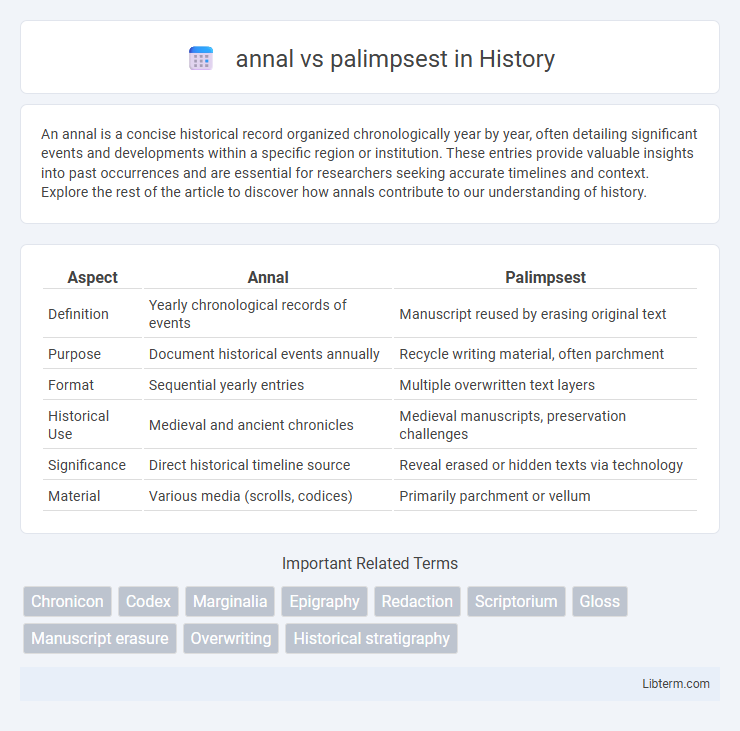An annal is a concise historical record organized chronologically year by year, often detailing significant events and developments within a specific region or institution. These entries provide valuable insights into past occurrences and are essential for researchers seeking accurate timelines and context. Explore the rest of the article to discover how annals contribute to our understanding of history.
Table of Comparison
| Aspect | Annal | Palimpsest |
|---|---|---|
| Definition | Yearly chronological records of events | Manuscript reused by erasing original text |
| Purpose | Document historical events annually | Recycle writing material, often parchment |
| Format | Sequential yearly entries | Multiple overwritten text layers |
| Historical Use | Medieval and ancient chronicles | Medieval manuscripts, preservation challenges |
| Significance | Direct historical timeline source | Reveal erased or hidden texts via technology |
| Material | Various media (scrolls, codices) | Primarily parchment or vellum |
Understanding Annals: Definition and Historical Significance
Annals are chronological records of events organized year by year, serving as primary sources for understanding historical timelines and societal developments. They provide detailed accounts of political, cultural, and natural occurrences that shaped civilizations, often maintained by monks or official chroniclers to preserve collective memory. The structured format of annals contrasts with palimpsests, which are manuscripts reused and overwritten, highlighting annals' role in preserving unaltered historical data.
What is a Palimpsest? Origins and Evolution
A palimpsest is a manuscript or piece of writing material on which the original text has been scraped or washed off to make room for new writing, often revealing multiple layers of text. Originating from the Greek words "palin" meaning "again" and "psestos" meaning "scraped," palimpsests were commonly used in ancient and medieval times due to the high cost of writing materials like parchment. Over time, advances in chemical analysis and imaging technologies have enabled scholars to recover and study the underlying texts, offering valuable insights into historical documents and lost literature.
Key Differences Between Annals and Palimpsests
Annals are historical records that chronologically document events year by year, primarily focusing on factual and temporal accuracy, whereas palimpsests are manuscripts or documents that have been reused by scraping or erasing previous texts, often containing layered historical information. Annals emphasize continuity and chronological order, serving as primary sources for historians to track sequential events, while palimpsests provide unique insights into historical writing practices and textual transmission due to their physical and textual layering. The key difference lies in annals being systematic historical records, whereas palimpsests are material artifacts revealing the evolution of texts through physical alteration.
The Role of Annals in Recording History
Annals serve as chronological records that document historical events year by year, providing a structured timeline essential for understanding the sequence and context of past occurrences. Unlike palimpsests, which are manuscripts with overwritten texts revealing layers of historical writing, annals prioritize accuracy and continuity over interpretative rewriting. Scholars rely on annals as primary sources to reconstruct historical narratives, as they offer precise dates and concise entries critical for tracing developments in political, social, and cultural history.
Palimpsests: Layers of Lost and Recovered Texts
Palimpsests reveal the complex history of manuscripts through layers of erased and overwritten texts, showcasing recovered writings beneath the visible script. Scientific techniques like multispectral imaging enable scholars to uncover these hidden layers, providing valuable insights into ancient literature, legal records, and historical narratives. The study of palimpsests enhances our understanding of textual transmission, preservation, and cultural heritage across centuries.
Preservation and Discovery: Annals vs. Palimpsests
Annal records offer a systematic chronological preservation of historical events, often maintained continuously with minimal alteration, ensuring reliable long-term documentation. Palimpsests, by contrast, reveal layers of overwritten texts where earlier writings are preserved beneath newer ones, providing unique opportunities for discovery through modern imaging techniques. The process of uncovering original texts in palimpsests requires advanced preservation methods to prevent damage, highlighting their dual role in safeguarding and revealing historical knowledge.
Literary and Cultural Impacts of Annals
Annals serve as chronological records that shape historical consciousness by preserving sequential events, influencing literary genres like historiography and biography through their factual tone and structured format. Their cultural impact lies in legitimizing historical narratives and fostering collective identity within societies by documenting political, religious, and social milestones. The annalistic tradition contrasts with palimpsests, which embody layered reinterpretations, while annals emphasize continuity and authoritative memory in cultural heritage.
Palimpsests in Medieval Manuscript Tradition
Palimpsests in the medieval manuscript tradition represent reused parchment where original texts were scraped or washed off to make room for new writing, preserving layers of historical information beneath the surface. These documents are crucial for scholars studying lost works, as advanced imaging techniques can recover the erased texts, revealing insights into medieval literature, religious, and administrative history. The complexity of palimpsests highlights the resourcefulness in manuscript preservation and the evolving nature of textual transmission during the Middle Ages.
Modern Approaches to Studying Annals and Palimpsests
Modern approaches to studying annals incorporate digital humanities techniques such as text mining and data visualization to analyze chronological structures and thematic patterns. Palimpsests benefit from multispectral imaging and chemical analysis, revealing erased or overwritten texts and enabling reconstruction of historical layers. Integrating these methods enhances understanding of textual transmission and historiographical practices in medieval and early modern manuscripts.
Annals and Palimpsests: Shaping Historical Memory
Annals and palimpsests play distinct roles in shaping historical memory, with annals providing chronological records of events, often year by year, that offer a structured narrative of the past. Palimpsests, on the other hand, contain layers of overwritten texts revealing the evolution of historical documentation and cultural transmission over time. Together, these sources enrich our understanding of historiography by highlighting both continuous memory preservation and the dynamic reinterpretation of historical knowledge.
annal Infographic

 libterm.com
libterm.com